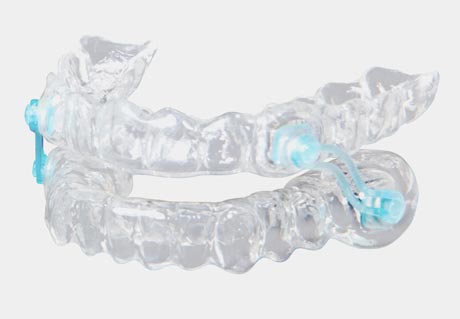Did you know our office is trained to help treat and manage your snoring and sleep apnea?
The American Academy of Dental Sleep Medicine (AADSM) is an association of dentists who help patients control obstructive sleep apnea and snoring through the use of oral appliance therapy (OAT). If you have trouble tolerating Continuous Positive Airway Pressure (CPAP) and need an effective alternative for living with sleep apnea, call us today about how OAT can help you get a good night’s rest.
Oral Appliance Therapy (OAT) is a treatment for obstructive sleep apnea and an effective alternative treatment to CPAP. Administered by our dentists, Oral Appliance Therapy uses a custom-fit “mouth guard-like” device worn only during sleep to maintain an open, unobstructed airway.
Obstructive Sleep Apnea
Obstructive Sleep Apnea is very common and potentially life-threatening medical disorder that prevents airflow during sleep. More than 18 million Americans have sleep apnea, and many are not receiving treatment.
Sleep apnea occurs when tissue in the back of the throat collapses and blocks the airway, reducing the amount of oxygen delivered to all of your organs including your heart and brain. People with sleep apnea may snore loudly and stop breathing for short periods of time. When the blood-oxygen level drops low enough, the body momentarily wakes up. It can happen so fast that you may not be aware you woke up. This can happen hundreds of times a night, and you may wake up in the morning feeling unrefreshed.
In addition to snoring and excessive daytime sleepiness, sleep apnea can cause memory loss, morning headaches, irritability, depression, decreased sex drive and impaired concentration. Sleep apnea patients have a much higher risk of stroke and heart problems, such as heart attack, congestive heart failure and hypertension. Sleep apnea patients are also more likely to be involved in an accident at the workplace or while driving.
Signs of Sleep Apnea
Sleep apnea patients are often older, obese and have thick necks, but men and women of any age or body type can have sleep apnea. The sleep disorder progressively worsens with age and weight gain. Listed below are some common signs of sleep apnea.
- Unintentionally falling asleep during the day
- General daytime sleepiness
- Unrefreshed sleep
- Fatique
- Insomnia
- Waking from sleep with a choking sound or gasping for breath
- Loud snoring
If you have any of these symptoms, you might have sleep apnea. Schedule and appointment at our office for an overnight sleep study.
Diagnosing Sleep Apnea
A physician is required to perform an overnight sleep study to properly diagnose obstructive sleep apnea. The test, also known as a Polysomnogram, will chart your brain waves, heart beat and breathing during sleep. It also records arm and leg movement.
A sleep specialist will look for other conditions that may mimic or worsen the symptoms of OSA, such as:
- Another sleep disorder
- A medical condition
- Medication use
- A mental health disorder
- Substance abuse
A sleep specialist will take your symptoms into consideration during diagnosis. Prior to the appointment, ask your partner if you snore loudly, stop breathing or gasp for breath during the night. The sleep specialist will also want to know if you gained weight or stopped exercising before your symptoms began.
Links to Pre-Sleep Study Questionnaires
These questionnaires will help us determine if the patient can be considered a sleep apnea patient. These are questionnaires are designed so that patients can fill them out prior to ever seeing a doctor to determine if they are candidates for sleep study and/or sleep appliance. These are secure websites that load directly into our Dental Records.
Sleep Links:
- Sleep History/Exam/Workup
- Sleep Appliance Adjustment Follow-Up
- Sleep Long Term Follow-Up
- Sleep Screening Consultation
TMD Links:
Other Links:
Treatment Options
Once you are diagnosed with obstructive sleep apnea, our office can provide you with Oral Appliance Therapy. This technique may be used alone or in combination with other treatments for sleep apnea, including behavioral changes or CPAP. Behavioral therapies include weight loss, avoidance of alcohol and tobacco and sleeping on you side, and may reduce the severity of sleep apnea.
Oral Appliances

Oral Appliances (OA) are a front-line treatment for patients with mild to moderate Obstructive Sleep Apnea (OSA) who prefer OAs to Continuous Positive Airway Pressure (CPAP), or who do not respond to CPAP, are not appropriate candidates for CPAP, or who fail treatment attempts with CPAP or treatment with behavioral measures such as weight loss or sleep position change. This small plastic device fits in the mouth during sleep like a sports mouth guard or orthodontic retainer. Oral appliances help prevent the collapse of the tongue and soft tissues in the back of the throat, keeping the airway open during sleep and promoting adequate air intake. Oral appliances may be used alone or in combination with other treatments for sleep-related breathing disorders, such as weight management, surgery or CPAP.
Advantages of Oral Appliance Therapy
- Oral appliances are comfortable and easy to wear. Most people find that it only takes a couple of weeks to become acclimated to wearing the appliance.
- Oral appliances are small and convenient making them easy to carry when traveling.
- Treatment with oral appliances is reversible and non-invasive.
How Oral Appliances Work
- Repositioning the lower jaw, tongue, soft palate and uvula
- Stabilizing the lower jaw and tongue
- Increasing the muscle tone of the tongue
Standards of Care
- Patients with primary snoring or mild OSA who do not respond to, or are not appropriate candidates for treatment with behavioral measures such as weight loss of sleep-position change.
- Patients with moderate to severe OSA should have an initial trail of nasal CPAP, due to greater effectiveness with the use of the oral appliances.
- Patients with moderate to severe OSA who are intolerant of or refuse treatment with nasal CPAP. Oral appliances are also indicated for patients who refuse treatment, or are not candidates for tonsillectomy and adenoidectomy, cranofacial operations, or tracheostomy.
Oral Appliance Therapy
Oral appliance therapy involves the selection, fitting and use of specially designed oral appliance that maintains an open, unobstructed airway in the throat when worn during sleep. Custom-made oral appliances are prevent to be more effective than over-the-counter devices, which are not recommended as a screening tool nor as a therapeutic option.
Our office is familiar with the various designs of appliances and can help determine which is best suited for your specific needs. A board certified sleep medicine physician must first provide a diagnosis and recommend the most effective treatment approach.
Ongoing care, including short and long-term follow-up is an essential step in the treatment of snoring and Obstructive Sleep Apnea with Oral Appliance Therapy. Follow-up care serves to assess the treatment of your sleep disorder, the condition of your appliance, your physical response to your appliance, and to ensure that it is comfortable and effective.
